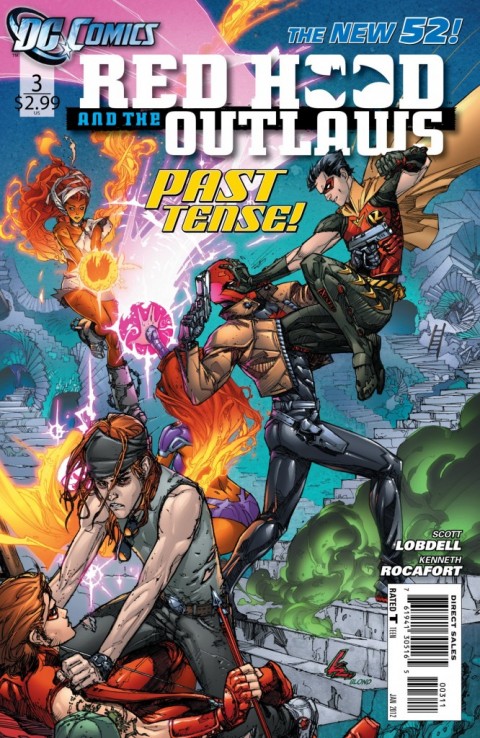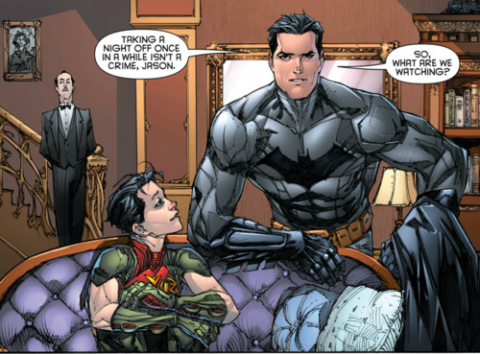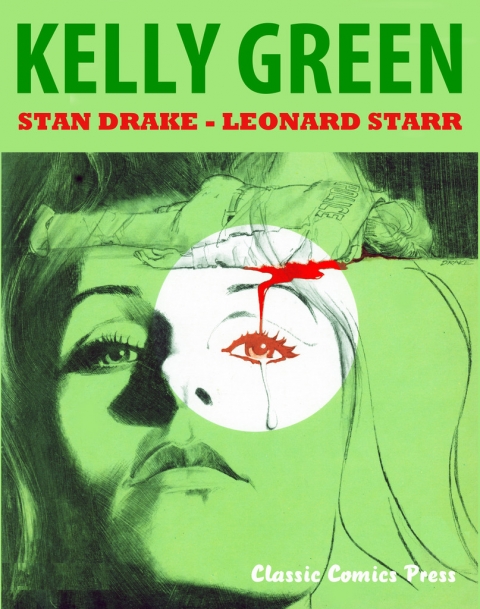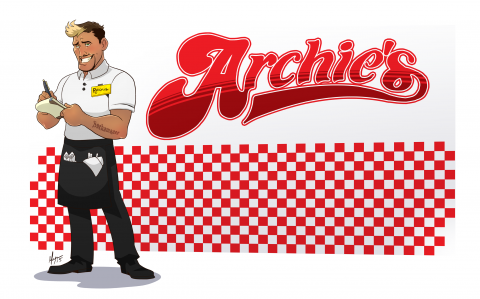Writer: Scott Lobdell
Artist: Kenneth Rocafort
Inker/Colourist: Blond
Letterer: Pat Brosseau
Cover: Kenneth Rocafort and Blond
Publisher: DC Comics
Last week DC released the third issue of one of its less prominent books in Red Hood and the Outlaws #3. Having gained more notoriety with its first issue it seems for its reportedly over-sexualized artwork than its own merits, let’s take a look at this latest release from DC’s New 52.
The Road So Far…
The unlikely team of Jason Todd, Arsenal and Starfire find themselves half-way across the world in the Himalayas face to face to with a 4,000 year being named S’aru. As the team delves deeper and deeper into the former Robin’s past, S’aru peers closer and closer into their souls.
What’s the Story?
As the team digs further into Jason’s past, they come face to face with S’aru, the 4,000-year-old gatekeeper of “The Chamber of All.” As payment to gain entrance to the chamber, S’aru temporarily removes the most cherished memory from each of their consciousnesses. Now moving forward into the insanity of the chamber’s nexus, the trio yammers back and forth about Jason’s old stomping grounds as S’aru gleams into the memories of Jason’s teammates; first Starfire before Roy sometime later. Nearing the core of the inner chamber, they move closer to their goal, but are prevented from moving forward when the chamber’s series of traps are sprung on them unexpectedly.
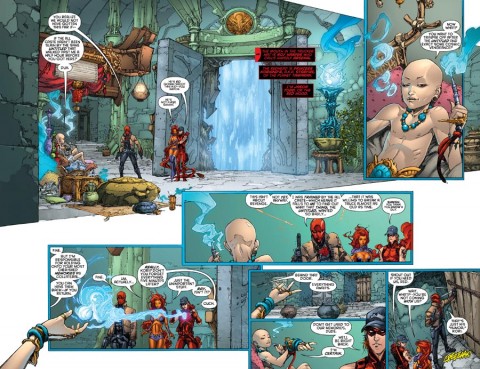
No sooner is the trap sprung do they realize that the jagged spines coming out of the ground are attached to a gigantic monster, which the three promptly attack and try to take down. After a time, the monster swallows Starfire, summing up their success thus far as Jason and Arsenal regroup, despite Jason having retrieved their prize: a snow globe of Colorado. As S’aru gleams Roy’s memory, Starfire forces her way out of the monster, blowing him up as she flies out, grabs Jason and Roy and moves to safety. They return to S’aru’s chamber with their prized snow globe, and regain their prized memories. Jason refuses his though, and allows S’aru to keep it. We later find out Jason’s most cherished memory was a night long ago when he was still Robin and was too sick to patrol with Bruce, and Bruce stayed behind to take care of him.
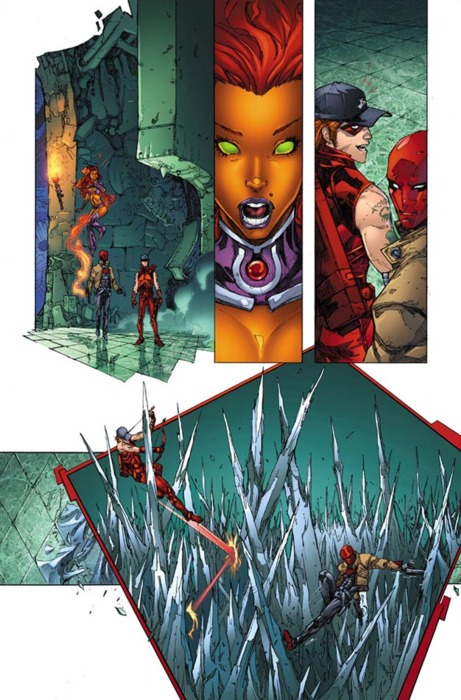
Red Hood and the Outlaws is a book which after three issues has very little momentum behind it, despite expanding beyond the teenage boy humour from the first issue. Here we find a layer of depth to Jason, which is good because this is in effect his book and Starfire and Arsenal are simply here because they’re mostly irrelevant in the rest of the DCU at the moment. The book seems to try and recapture the feel of Judd Winick’s Outsiders series by putting together a strange team of characters and having them interact, but the problem is that it fails to reach that level of quality in this issue. With Todd as the star of issue three, the book’s success depends on the level to which readers can relate, empathize or even sympathize with him. I feel Lobdell took a step in that direction with issue three where we find Jason’s most cherished memory is actually one of him and Bruce Wayne staying home one night where Todd was sick, and Bruce looked after him and they watched television together. It’s here we find ground with the character, peeling back the layer of his character a little more beyond what both Grant Morrison and Judd Winnick have been able to do with him. We find him to be complex than first thought, but at the same time, clearly very bitter and tortured evident through his willingness to forfeit the memory to S’aru. I liked this piece of the story, but the rest of the plot seems light and functions in spiritual dressing alone. I find Jason Todd’s arc as an individual far more compelling than the greater story, and with Arsenal and Starfire not really adding anything to the mix, this book may only see limited success.
The Pretty, Pretty Pictures
The artwork was really nicely done, although it’s hard to point to any one panel that has an element of “awe” attached to it. Even so, the work is solid, anchored by Rocafort’s pencils and brought to life by the digital colouring and inking of Blond. The book’s art is very colourful, finely detailed and is in actuality one of the high points of this book. Pages such as the group in the inner chamber where there are seemingly staircases moving in every which direction towards an endless number of entrances. The panel arrangement is a nice change of pace, with the panels not following a straight-forward horizontal placement, but rather in one case, begins with a panel set in Gotham with Arsenal and Killer Croc throwing down on a rooftop.
From there, Rocafort dabbles in unconventionality creating three successive smaller panels of action in between three larger panels displaying their fisticuffs at various stages. With a oddly shaped panel pointing downward, the next stage of the fight continues with a weary Roy egging on the much larger reptilian foe. It’s a little unusual to arrange a page this way, but unusual in a good way. There are other great examples, such as when Starfire comes blazing out of the monster, notably the middle panel where a large explosion envelopes the page, and Starfire flies off while grabbing her cohorts on the way. If there were to be one complaint it’s the continued over-sexualization of the Starfire character, which considering a generation of kids watched the Teen Titans cartoon, the composition of the character may come as a shock to them. To be fair, the artwork is less risque compared to the first issue, but still very overdone.
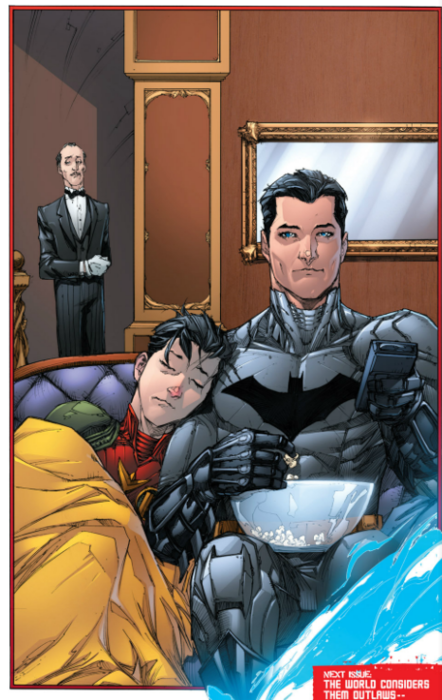
Final Thoughts
Rocafort’s artwork, despite some of his Starfire compositions, is the creative high point of this issue and this series. It excels where Lobdell’s plot flounders and is consistently good throughout the book. His creativity has taken the book by storm, moving beyond a formulaic page arrangement and shifting the panels around, using different shapes and breaking away from conventional page design to tell the story quite well. The plot itself though is sparse. Lobdell’s concept of the Red Hood and his outlaws bring Jason Todd centre stage, but in a plot that has very little staying power. The book’s success will extend as far Jason’s fan base, as his comrades don’t have enough of a following to really help carry this book. DC seems to have put all of their eggs in a single basket, and while I felt this issue had an interesting message, altogether the book has little chance of long-term success as a title that is basically “The Punisher and friends.”

